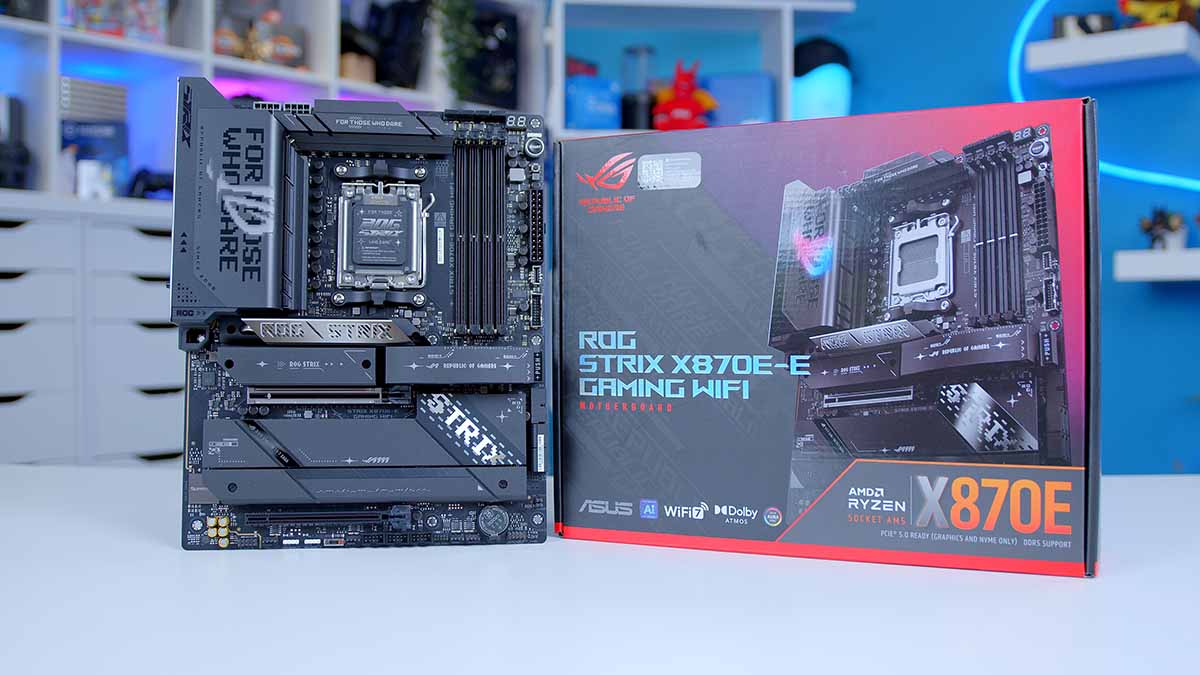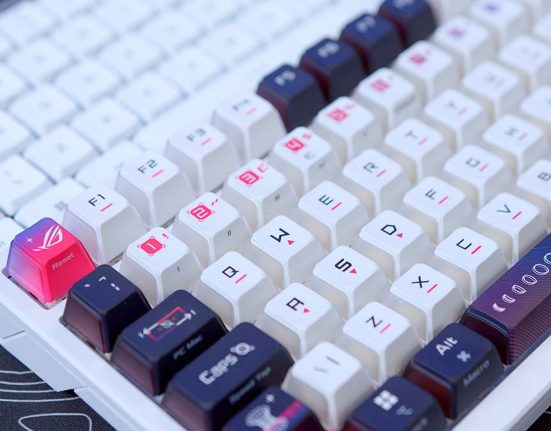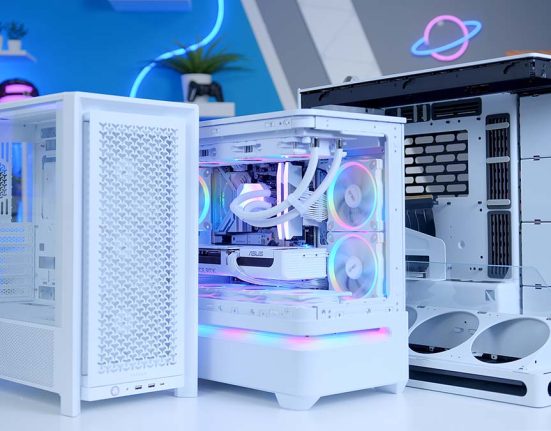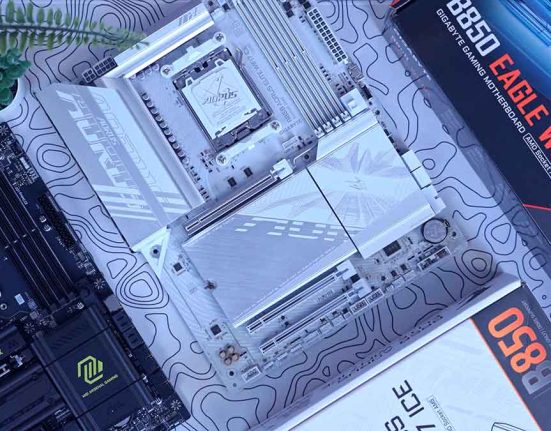The ASUS ROG Strix X870E-E Gaming WiFi is one of the flagship motherboards launched a month after the AMD Ryzen 9000 CPUs hit the shelves. This top-end motherboard focuses on features catering to enthusiasts. It utilises many AI enhancements, improves RAM overclocking, provides plenty of VRM power phases for CPU overclocking, and offers a whole host of connectivity and IO for those building a powerful system. As this is a brand new board specifically geared towards Ryzen 9000 builds, we’ve tested and analysed the ROG Strix X870E-E to see how it differs from the previous generation.
Due to their affordability, Ryzen 7000 chipset boards are still prevalent in the current market. Considering these boards are also fully compatible with the Ryzen 9000 range of CPUs, this will likely make the X870 and X870E boards a challenging sell. Many will appreciate the new features that come with Zen5. Still, it’ll be interesting to see where pricing sits compared to Zen4, especially considering how cheap the previous generation of boards is.
In this motherboard review, we’ll examine the specs, design qualities, and features of the ASUS ROG Strix X870E-E in depth to see how it compares to the previous generation of flagship motherboards.
Buy the ASUS ROG Strix X870E-E Gaming WiFi on:
Specification
The specs clearly show that the ROG Strix X870E-E Gaming WiFi is a top-end motherboard. The ‘X#70E-E’ range has retained the ATX form factor, which is excellent. While some will appreciate a bigger E-ATX board, ATX is much better from a versatility standpoint, as more modern cases support this form factor over E-ATX.
Regarding overclocking support, the Ryzen 9000 boards place a much bigger emphasis on overclocking due to stability changes that have improved how fast RAM can be pushed. The two flagship ASUS boards use a proprietary technology called ‘NITROPATH’, which minimises noise interference and optimises the signals to and from RAM. This allows RAM DIMMs to clock up to 400MT/s higher, hence the 8400MT/s cap on this board.

This board has the same number of VRM power phases (an 18+2+2 configuration) as the X670E version, but overclocking has been tuned to improve performance. A dynamic OC switcher allows enthusiasts to easily switch between a manual overclock for multi-threaded workloads and PBO (precision boost overdrive) for single-threaded tasks. PBO can also ramp up more than before, while base clock speeds can be manipulated to impact power and temperature limits better.
Regarding connectivity, the ROG Strix X870E-E Gaming WiFi focuses more on Gen5 support. ASUS has decided to drop the second Gen5 PCI-E x16 slots, but there’s more bandwidth for storage, of which there are three Gen5 M.2 slots and two Gen4. This is similar to its X670E counterpart, but the extra Gen4 option is a solid value-add.
| Specification | ASUS ROG Strix X870E-E Gaming WiFi |
|---|---|
| Form Factor | ATX |
| Supported Memory | 192GB DDR5 8400MT/s |
| PCI-E x16 Slots | 1 x PCI-E 5.0 1 x PCI-E 4.0 |
| PCI-E x4 Slots | 3 x PCI-E 5.0 2 x PCI-E 4.0 |
| VRM Power Phases | 18+2+2 |
| Front IO | 1 x USB 3.2 Gen2x2 Type-C 2 x USB 3.2 Gen1 Type-A 3 x USB 2.0 |
| Rear IO | 2 x USB4 Type-C 1 x USB 3.2 Gen2x2 Type-C (30W PD) 9 x USB 3.2 Gen2 Type-A 1 x USB 3.2 Gen2 Type-C |
| Audio | 1 x Optical S/PDIF 2 x Audio Jacks |
| Networking | 5 Gigabit LAN WiFi 7 |
Connectivity has been significantly amped up across the front and rear IO. On the front, gamers can leverage a USB 3.2 Gen2x2 Type-C header, two USB 3.2 Gen1 Type-A headers, and three USB 2.0 headers supporting six ports. Regarding the rear, there are thirteen ports: two USB 4 Type-C ports, rated at 40Gbps, followed by a USB 3.2 Gen2x2 Type-C port that offers 30W of fast charging power delivery. It also has nine USB 3.2 Gen2 Type-A ports and a USB 3.2 Gen2 Type-C port. There’s a massively solid selection here, and with all of the ports being high-speed, the IO is ideal for those building a workstation hybrid.
Audio has been dialled back compared to the X670E-E Gaming WiFi, with the X870E-E only coming with two 3.5mm jacks and an optical S/PDIF. While this isn’t a deal-breaker for us, it’s a shame this board doesn’t cater to those with advanced audio setups. The ROG STRIX X870E-E has received an upgrade for networking, now featuring 5 Gigabit LAN and WiFi 7. The WiFi 7 isn’t as exciting because it requires a supporting router to use the full speeds, but the 5 Gigabit LAN offers excellent speeds for those with a wired setup.
Pricing is likely the most significant point of contention for most prospective buyers. The ROG Strix X670E-E Gaming WiFi launched close to the $500 mark, a considerable amount of money to spend on a motherboard. The ROG Strix X870E-E may hit shelves at a lower price, but considering the available features, this seems unlikely.
What’s in the Box?
As per our motherboard reviews, this section briefly examines the additional accessories in the box. It’s relatively standard for a manufacturer to provide extra cables or gadgets that streamline the building process, so we’ll look at those now!
The first item is the WiFi 7 antenna. These slightly differ from the WiFi 6E antennas on the previous generation motherboards. They mostly look the same, but the actual connection to the rear IO has changed.

Instead of the hexagonal screw-on nuts, this antenna has a quick-connect mechanism. They snap into place and don’t require any screwing, which is a nice touch.

The rest of the box accessories are standard for a board of this calibre. A small pack contains two SATA data cables for those with SATA-based storage devices.

There is also a pack of cable ties. These are useful for cable management, and I prefer them over Velcro because they offer better tension.

The box also contains a thermal pad. This pad is specifically for M.2 22110 drives (larger than their 2280 counterparts). This is great for those with larger M.2 storage.

ASUS has also included some proprietary accessories that make building more accessible. This square piece of plastic is called a ‘Q-Slide’ and can mount any M.2 size up to 2280. It simply slides onto the metal underneath the slot as if on rails and can be adjusted to accommodate different drive sizes. There’s also a package with their Q-Latches that provides a tool-less way of installing or removing an M.2 SSD.

The rest of the box contains more novelty items, such as stickers and a key chain. These don’t impact a build’s user-friendliness, but they offer extra value beyond the scope of PC building.
ASUS ROG Strix X870E-E Gaming WiFi Design
The ASUS ROG Strix X870E-E Gaming WiFi is a board that exuberates sophistication. It is dipped in black from head to toe, including the PCB. The heatsinks are also coated in a sleek black finish, leaving little of the board uncovered.

The heatsinks are covered in the ROG-themed livery, with a bold ‘FOR THOSE WHO DARE’ text enveloping most of the rear IO heatsink. Compared to the previous generation X670E-E motherboard, the X870E-E is much more refined. I like that the colouring is consistent across the board. ASUS removed the distracting light array on top of the rear IO. Instead, this has been replaced with a much less aggressive ROG logo, which lights up when the board is powered on.

The one thing holding this board back is the PCB. Some may prefer the contrasting look between the sleek heatsinks and the rougher style of the various pins and headers, but I’m not a huge fan. The board could use more heatsinks to cover the areas around the RAM DIMMs or remove the second PCI-E x16 slot to further extend the heatsinks. Alternatively, a white version of this board with a white PCB and RAM DIMMs would look gorgeous.
This isn’t to say I dislike the look of the ROG Strix X870E-E Gaming WiFi. Overall, ASUS has created a stunning board many would happily include in their PC build. However, some design elements could be improved to refine the aesthetic further, making the ROG Strix X870E-E stand out more than the competition.

Connectivity Options
Graphics Card Slots
Strangely, the graphics card expansion options are among the few things on this board that I would consider a downgrade compared to the previous X670E-E version. On the ROG Strix X870E-E, ASUS have kept things simple. There are two GPU slots. The primary slot is Gen5 at full x16 speeds, while the secondary slot is Gen4, which only supports x4 mode. So, the second slot will likely be used for a PCI-E storage drive or a capture card.

The ROG Strix X670E-E had two Gen5 slots that could run at full x16 speeds or x8 with two cards. The downgrade won’t be an issue for some, primarily as SLI (scalable link interface) isn’t used anymore. But those looking to maximise performance with two graphics cards are losing out to a degree.
M.2 Slots
Storage is one of the more impressive areas of this board. The ROG Strix X870E-E Gaming WiFi has one extra Gen4 slot compared to the ROG Strix X670E-E, which opens up more space for games, big files, or perhaps content creation work. M.2 storage is separated into two distinct areas. The three Gen5 slots are all above the graphics card slot.
The slot on the right is easily accessed by pressing the ‘Q-Release’ button. The other two on the left have heatsinks that are secured to the motherboard with screws. So loosening the screws will free up the slots. All of these slots feature thermal pads, which is a nice touch.

The Gen4 slots are at the bottom of the motherboard, again, covered by a heatsink held in with screws. These drive slots don’t have any thermal pads, but they utilise the ASUS ‘Q-Latch’ mechanism, which provides an easy way to install or remove drives.

RAM DIMMs
The RAM configuration on this motherboard is pretty typical compared to other designs. Four DIMM slots support a maximum of 192GB on the board. RAM overclocking capability is similar to the ROG Strix X670E-E, but RAM on the ROG Strix X870E-E can be clocked up to 8400MT/s instead of 8000MT/s.

The main point about the RAM is that the actual DIMM slots have changed. ASUS has introduced ‘NITROPATH’, which reduces signal interference. Using shorter pins that connect to the RAM and improving the pathways on the motherboard increases data transfers between the RAM and the CPU. It’s unclear how much this will affect performance, but it’s an improvement regardless.

Rear IO
Rear IO connectivity is where things shift in ASUS’ favour. This board has a whopping thirteen ports. As a general rule of thumb, most boards will have eight to ten ports, but thirteen is unheard of, mainly because there are no USB 2.0 ports in sight.
One of the significant changes that’s arrived with Zen5 is more bandwidth. More bandwidth means more high-speed ports, so it’s no surprise that the ROG Strix X870E-E is loaded with them.

The main ports worth highlighting are the USB4 Type-C ports. We saw a few boards with USB4 on the X670E chipset, but USB4 is a mainstay across the entire Ryzen 9000 options. Additionally, there are nine excellent USB 3.2 Gen2 Type-A ports (coloured in red).
For networking, gamers can use 5 Gigabit LAN, which translates to 5000Mbps. This is an ideal connection speed for those with a home server or needing to shift large files. WiFi 7, while helpful, is slightly more situational. Because this standard is still propagating across the router market, there aren’t many users with a WiFi 7-compatible router, which means not everyone can leverage these speeds.
Audio connectivity is slightly lacking compared to the ROG Strix X670E-E. This board only has two 3.5mm jacks and an optical S/PDIF out. This will limit those with complex speaker setups.
Internal Headers
CPU and Motherboard Power
The power connectors on this motherboard are nothing exciting. There have been minimal changes from the X670E version, resulting in a lack of visible differences between the VRM power phases on both boards. The ROG Strix X870E-E Gaming WiFi uses two 8-pin EPS CPU connectors. Plugging in both headers will spread power better, resulting in slightly lower temperatures.

Again, the headers for motherboard power are pretty typical. There is a 24-pin motherboard connector on the right-hand side of the board. ASUS hasn’t included an additional 4-pin ATX connector commonly used for overclocking on specific boards.

Front USB Headers
As covered in the specs section of this article, the front IO offers a solid range of ports. USB 3 and USB-C are in their typical spots, just underneath motherboard power. The USB-C header has enough juice for one port, while the two USB 3 headers accommodate four USB 3.2 Gen1 ports.

Fortunately, the USB 2.0 headers are located all in one place. There are three headers in total, supporting a maximum of six ports. It’s great to see plenty of USB 2.0 headers on this board, as cooling devices (including fans) are starting to use these more to supply data.

Pump and Fan Headers
All the pump and fan headers on the ROG Strix X870E-E are PWM (4-pin) headers. While it’s not uncommon to see DC headers on modern boards, PWM is used more to extrapolate more power for higher RPMs.
Four headers are located at the top of the board. From left to right, they are ‘CPU_FAN’, ‘SYS_FAN’, ‘AIO_PUMP’, and ‘CHA_FAN5’. This amount of headers will be ample for most builders, and being located at the top makes them more convenient to plug in.

The rest of these fan headers are at the bottom of the motherboard, just underneath the secondary graphics card slot. These are ‘CHA_FAN1’ and ‘CHA_FAN4’ from left to right. It’s fantastic that there’s ample cooling support on the ROG Strix X870E-E, as an enthusiast is much more likely to plug in plenty of fans or coolers for better thermals.

RGB Headers
ASUS has provided three addressable 3-pin RGB headers on the ROG Strix X870E-E motherboard. Two are at the bottom next to the fan headers, and the third is at the top of the board, just above the start button. Ultimately, it would be great to see more of these, but those with plenty of RGB components will be able to power everything with some splitters.

SATA Data Ports
While SATA data isn’t used as much anymore, most manufacturers provide a few ports for those with SATA storage. The ROG Strix X870E-E has four right-angled ports.

Building with the ROG Strix X870E-E Gaming WiFi
Building with the ASUS ROG Strix X870E-E Gaming WiFi was an absolute breeze. Thanks to the enormous range of usability features, installing components was made incredibly easy and could be done (mostly) without any tools. This means slotting in the graphics card and storage is straightforward.
Because this is an ATX design, it easily slots into the case we chose during our build without any clearance issues. There are ample headers to get everything plugged in. Those with multiple fans will find solace because they likely won’t need to use splitters to power anything.
The integrated IO shield also made installing this motherboard into a case quite simple. It would be odd if the ROG Strix X870E-E didn’t have an integrated IO shield based on its price, but it’s a feature we appreciate either way.
Overall, building with the ROG Strix X870E-E Gaming WiFi was simple. This board’s sheer versatility is impressive, and it shouldn’t be hard for a first-time builder, either. My only wish is for a BTF version to hide all cables, allowing us to build an immaculate system.
Features We Like
DIY-Friendly Features
As discussed throughout this review, the ROG Strix X870E-E Gaming WiFi has many usability features that simplify the building process.
For example, the Gen5 M.2 slot on the right-hand side of the board will be accessible once the heatsink is removed. However, instead of loosening some screws, there is a small button that can be pushed, freeing the heatsink from the slot.

Alternatively, all of the M.2 slots feature an ASUS Q-Latch, which allows them to be installed without the need for small finicky screws. M.2 SSDs can be pushed down and locked into place.

There are many other features, such as the PCI-E slot release mechanism, the M.2 Q-slide, or the WiFi 7 antenna click install. This board is cleverly designed to make PC building accessible, and it’s impressive how much ASUS has managed to cram in here.
Q-Code LED
To test all of the components we review, they must be installed in a build. Because we test so many components, we sometimes encounter errors or issues that aren’t always easily diagnosed.

This is where the Q-Code LED comes in. This small display shows boot codes when the PC is switched on, and it has often saved our bacon. More boards should offer this LED, as it provides a simple way to diagnose and troubleshoot errors in a PC build, allowing us to get to the root of the issue quicker.
Features We Don’t Like
WiFi 7 Requires a Compatible Router
WiFi 7-enabled routers have slowly saturated the market over the past year, but because of their high prices, they’re not accessible to everyone. For this reason, a huge range of prospective buyers will not be able to fully use WiFi 7 speeds and stability. This makes the WiFi 7 support on this board somewhat redundant for a significant number of gamers.

Conclusion
ASUS ROG Strix X870E-E Gaming WiFi

Product Name: ROG Strix X870E-E Gaming WiFi
Brand: ASUS
-
Features
-
Design
-
Performance
-
Value For Money
Summary
The ASUS ROG Strix X870E-E Gaming WiFi motherboard has impressed me. I was expecting this Zen5 iteration to offer some minor upgrades compared to the previous X670E version, but ASUS has put in a tremendous amount of work to make this board a highly standout competitor. This board offers excellent connectivity and high-speed options, including USB4 and 5 Gigabit LAN support. Expansion is solid, and the internal IO caters to those looking to build a beefy system with plenty of high-end components. However, the most notable quality is the sheer usability of the features on this board. The ROG Strix X870E-E Gaming WiFi is designed to make building a PC effortless and easily meets this criteria.
Regarding caveats, the ROG Strix X870E-E Gaming WiFi is a board that I can’t entirely fault. There are a couple of small cons, such as the aesthetic, the requirement of a WiFi 7 router, and the fact that it’s expensive. However, this board is targeted as an enthusiast-level component designed to offer a builder a ridiculous amount of connectivity and expansion options for a hefty configuration. Do I think the price is entirely justified? No. But at the same time, ASUS hasn’t built this board to be cheap, and if you’re building a top-end system, price will be a low priority versus aesthetics and features. Overall, the ROG Strix X870E-E Gaming WiFi is an excellent motherboard worth picking up for a high-end build.
Pros
✅ Incredibly versatile
✅ Excellent connectivity
✅ Easy to build with
Cons
❌ Needs a WiFi 7 router
❌ Expensive
❌ No SLI capability



![FI_[DM78] Corsair Air 5400 + 5090 Gaming PC Build](https://geekawhat.com/wp-content/uploads/2025/11/FI_DM78-Corsair-Air-5400-5090-Gaming-PC-Build-551x431.jpg)

![FI_[DP051] Antec C5 + 5070Ti Gaming PC Build](https://geekawhat.com/wp-content/uploads/2025/11/FI_DP051-Antec-C5-5070Ti-Gaming-PC-Build-551x431.jpg)


